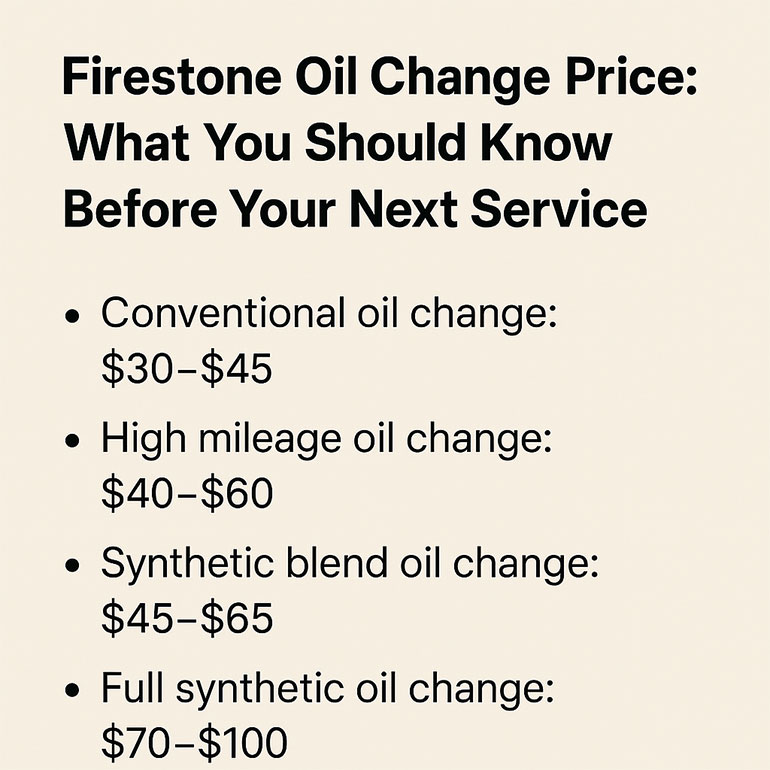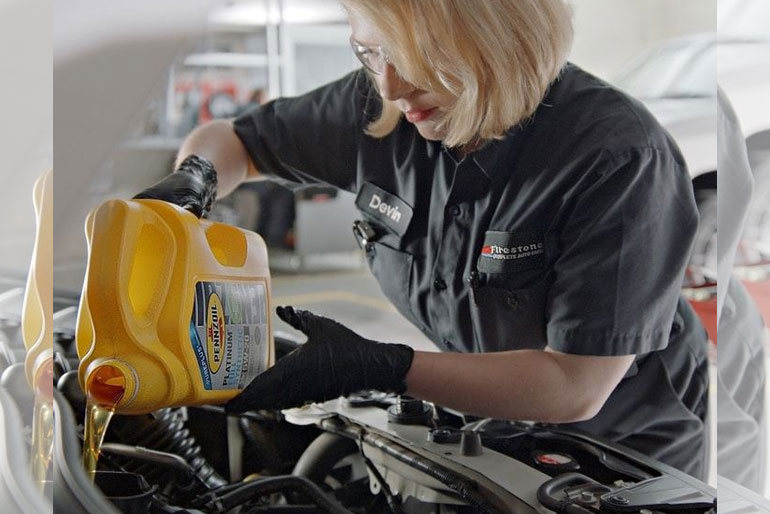When it’s time for an oil change, one of the first names that comes to mind is Firestone Complete Auto Care. They’ve been around for decades, handling everything from tires and brakes to engine repairs and tune-ups. But for many drivers, the most common visit to Firestone is for an oil change. If you’ve ever wondered what their prices look like, what options you’ll get, and whether it’s worth the money, you’re in the right place.
In this article, we’ll walk through everything you should know about Firestone oil change prices. We’ll cover the types of oil changes they offer, the typical costs, how their services compare to other shops, and tips to save money on your next visit. Let’s break it down step by step in a straightforward way.
Why an Oil Change Matters
Before diving into the price side of things, it helps to remember why an oil change is so important. Think of oil as your car’s lifeblood. It keeps the engine parts moving smoothly, reduces friction, and carries away dirt and debris. Over time, oil breaks down and becomes less effective. If you let it go too long, your engine could overheat or even suffer permanent damage.
That’s why regular oil changes are one of the cheapest but most valuable ways to keep your car running for years. Most vehicles need an oil change every 3,000 to 7,500 miles, depending on the type of oil used, your driving habits, and your car’s make and model. Firestone offers services for all of these intervals.
Firestone Oil Change Options
When you roll into a Firestone shop, you won’t just see one flat price for oil changes. They have several packages depending on the kind of oil your car needs and the level of service you want. Here are the main choices you’ll find:
- Conventional Oil Change
- The most basic and affordable option.
- Works well for older cars or vehicles that don’t rack up a ton of miles.
- Usually needs to be replaced every 3,000–5,000 miles.
- High Mileage Oil Change
- Designed for cars with more than 75,000 miles.
- Includes special additives to help reduce leaks, protect worn engine parts, and slow down oil burn-off.
- A bit pricier than conventional, but a smart choice for aging vehicles.
- Synthetic Blend Oil Change
- A middle ground between conventional and full synthetic.
- Offers better protection and lasts longer than conventional oil.
- Good for drivers who want extra performance without paying top dollar.
- Full Synthetic Oil Change
- The premium option.
- Provides the best protection, especially for modern engines, turbocharged engines, or extreme driving conditions.
- Lasts longer—often up to 7,500 miles or more.
- Best choice if you want fewer oil changes per year.
Each package also includes more than just oil. Firestone usually throws in extras like a new oil filter, a quick inspection, and topping off other fluids.
Firestone Oil Change Prices
Now let’s get to the big question: how much does it cost? Prices vary slightly depending on location, but here are the average ranges you’ll likely see at Firestone:
- Conventional oil change: $30–$45
- High mileage oil change: $40–$60
- Synthetic blend oil change: $45–$65
- Full synthetic oil change: $70–$100
Keep in mind that certain vehicles, like trucks or luxury cars, may cost more because they need more oil or special filters. Also, prices can be higher in larger cities compared to smaller towns.

What’s Included in the Price?
When you pay for an oil change at Firestone, you’re not just paying for oil. Here’s what’s typically included:
- Fresh motor oil of your choice
- New oil filter
- A courtesy inspection (checking tires, brakes, lights, wipers, and other basics)
- Top-offs for fluids like windshield washer or coolant
- Tire pressure check
Some shops may also offer a quick vacuuming of your car or a free tire rotation with certain packages. It’s a good idea to ask before you book so you know exactly what you’re getting.
Firestone vs. Other Shops
How does Firestone compare to other places where you can get an oil change? Let’s look at some common competitors:
- Jiffy Lube: Often slightly more expensive than Firestone for synthetic oil changes, but they specialize in quick service.
- Walmart Auto Care: Usually cheaper, especially for basic oil changes, but may not include as many extras.
- Valvoline: Similar price range to Firestone, with the added perk of not needing an appointment.
- Dealerships: Usually the most expensive, though they’ll use manufacturer-specific oil and filters.
Overall, Firestone falls in the middle ground—cheaper than a dealership, but slightly pricier than a discount chain like Walmart. What sets Firestone apart is their nationwide presence and the fact that it can handle other repairs if your car needs them.
Tips to Save Money at Firestone
If you want to keep costs down, there are several ways to save on your next oil change at Firestone:
- Look for Coupons
Firestone frequently posts coupons on their website. You’ll often find discounts of $10–$20 off oil changes, especially for synthetic options. - Sign Up for Rewards
Their rewards program sometimes offers special deals or cash back after a certain number of visits. - Bundle Services
If you need other work done—like tire rotation, brake check, or alignment—ask if they have bundle packages. You might get a discount when combining services. - Check Local Ads
Individual Firestone shops may run local promotions, so it’s worth checking your local newspaper or online deals. - Ask About Price Matching
Some locations will match or beat competitors’ prices if you show proof.
Is a Firestone Oil Change Worth It?
So, should you go with Firestone for your next oil change? Here are some pros and cons:
Pros
- Nationwide locations make it easy to find a shop
- Several oil options for different vehicles and budgets
- Extra services like inspections and fluid top-offs are included
- Reputation for reliable, professional service
Cons
- Slightly higher prices than budget options like Walmart
- Wait times can be longer during busy hours
- Not always the cheapest for full synthetic oil
For most drivers, Firestone offers a good balance of price, service, and convenience. If you value having your car looked at by trained professionals and like the idea of a one-stop shop, the extra cost is often worth it.
How to Know Which Oil Change You Need
If you’re unsure which oil package to choose at Firestone, here are some quick guidelines:
- Conventional: Older cars, tight budgets, short trips
- High Mileage: Vehicles over 75,000 miles with wear-and-tear
- Synthetic Blend: Mid-range option for better protection
- Full Synthetic: Newer cars, long commutes, extreme weather, or performance vehicles
When in doubt, check your owner’s manual—it will tell you exactly what type of oil your car requires.
The Bottom Line
An oil change might feel like a small detail, but it’s one of the most important things you can do for your car. Firestone oil change prices range from around $30 for conventional up to about $100 for full synthetic, depending on your vehicle and location. While they aren’t the cheapest option out there, Firestone provides solid value through extra services, nationwide availability, and trustworthy work.
If you keep an eye out for coupons and promotions, you can get a quality oil change at Firestone without breaking the bank. At the end of the day, the peace of mind knowing your engine is protected is well worth the price.







